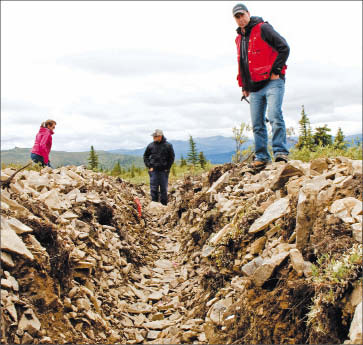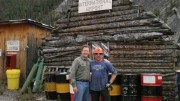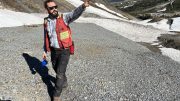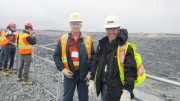Ever since the company started out in 2005, Kaminak Gold (KAM-V) has been about scale. When it first launched, the junior boasted 60,000 sq. km of land around Nunavut and B.C., a size that well-suited the company’s prospect-generator model.
Today, with a 50-by-12-km addition to its portfolio, the company can brag about having one of the largest land packages in one of the hottest geological addresses: the Yukon’s White Gold district.
The company, led by president and CEO Robert Carpenter, got into the Yukon early with an option deal and expanded aggressively before the second Yukon gold rush took hold.
Now, the company has put aside its prospect-generator model and is concentrating on its flagship Coffee project, which keeps giving up gold discoveries.
It was 2008 when Carpenter heard about intriguing results coming out of an upstart company called Underworld Resources that was exploring in the Yukon. He had never worked in the Yukon, but had spent significant time professionally in Nunavut and understood the unexplored potential of Canada’s North. He got on a plane to the western territory and linked up with none other than prospector Shawn Ryan, who showed him some sample results from a target called Supremo.
“Without exaggerating, the minute I saw it I knew it was the best geochemical signature I’d ever seen,” Carpenter says of the results.
While impressed with the initial data, Carpenter and the company still spent a couple months working with Ryan and looking at the data and geology before signing on to the deal. At the time, the financial crisis was still decimating the junior market and the Yukon rush was in its infancy, so competition was relatively light.
A few other companies were interested in the property, but Carpenter says that with $5 million on hand, Kaminak’s ability to work the project and its strong geological team helped give it an advantage.
At the time, the Supremo target covered a 1.5-by-2-km soil anomaly, and the company optioned a 76.8-sq.-km land package covering the Coffee, Cream and Kirkman properties. The deal, announced in May 2009, called for $250,000 in exploration, 250,000 shares and $75,000 cash to Ryan that year, plus later commitments of $1.5 million in exploration, 1.5 million shares and $325,000 in cash over three years, and a 2% net smelter return royalty.
Scaling up
Jump forward less than three years, and Kaminak is wrapping up a $20-million exploration and development season on a Coffee project that now spans 607 sq. km, with several high-priority targets and a wealth of data.
The company should complete 45,000 metres of diamond and reverse-circulation (RC) drilling this year, plus 11,000 soil samples near the close and 20,000 samples already collected as part of its regional exploration.
Kaminak’s exploration program targeted the advanced Supremo, Latte and Double Double zones. It also tries to find time to drill secondary targets along the 15-km trend it has identified. The company describes the 2011 strategy as “aggressive expansion drilling.”
“This year’s program was to show people that these things were real,” Carpenter says, adding that discoveries are great, but people are wondering if Kaminak can “put meat on the bone.”
On-site in August, Tim Smith, Kaminak’s vice-president of exploration, explained that the company has worked hard to get the most out of the 2011 season. Kaminak started drilling on April 15 with an RC drill, because it didn’t need the water trapped in frozen streams. Before long, it got three diamond drills turning.
“We probably had ten or fifteen diamond holes in before our competitors even started mobilizing,” Smith says. “We realize it’s a short season, so you’ve got to make hay when the sun shines.”
For their efforts, the company has been rewarded by expanding the strike lengths of several zones at Coffee.
Most recently, the company released 44 holes from the Latte zone that extended the strike length from 700 metres to almost 1.4 km, as well as to a depth of 275 metres. Hole 127, the farthest westward step-out hole at 400 metres, hit 12 metres grading 2.7 grams gold, while eastward, hole 48 hit 9 metres averaging 5.55 grams gold 350 metres out.
With Latte still open to the east and west, Kaminak is looking excitedly at the Kona target 2.5 km west and the Double Double target 1 km east. The company noted in the results that previously defined gold-in-soil anomalies and geophysical data suggests the three zones may connect.
The company’s drilling on the T3 target at Supremo has extended its strike length by over 600 metres, with results including 27 metres grading 2.5 grams gold, 6 metres grading 10.4 grams gold, 9 metres averaging 6.1 grams gold and 17 metres carrying 2.3 grams gold. A further six structures at Supremo have seen little to no drilling.
And then at Double Double, the company pulled its best hit yet at Coffee, and one of the best in the Yukon, with a 4-metre intercept grading 74.9 grams gold from 105 metres downhole, along with several other encouraging intercepts.
Following the early August hit, Kaminak’s stock price jumped 58¢ in one day to $4, though it has since been beaten back by market jitters, recently closing at $2.77 after hitting a low of $2.30.
But at the time of the site visit the results had only just been released, and Smith and Kaminak’s district geologist Alan Wainwright were clearly pleased with the results in their understated, professional way.
Looking at the actual intercept it was clearly prospective, but like everywhere at coffee it contained no visible gold, just fine-grained mineralization.
“We’re seeing a very fine, even distribution of gold,” Wainwright says. “So it’s going to make the job easy for estimation and resources.”
The gold is also free, with no indications of refractory gold, which helps explain how the company achieved cyanide recoveries over 97% in early metallurgical testing of the oxides from Supremo. The oxides at Supremo and Latte extend 75 metres vertically, and are as deep as 150 metres in places.
The Coffee technical report notes that the identified widespread gold mineralization is associated with fractured and hydrothermally altered rocks, and occurs in steeply dipping structural zones characterized by fragmental rock, silica and muscovite alteration, as well as minor veining. The nature of the relationship is not yet understood.
Despite the extensive drilling completed this year, which Smith notes would probably be sufficient for at least an inferred resource, the company is resistant to put a size potential on the project. Carpenter says he would hate to put a defined time on when the company would put out a resource, but did say, hesitatingly, that the market would be looking for an initial resource by the end of next year.
While Kaminak is resisting pressure for a resource, analysts have been making their own “back-of-the-envelope” estimates. Following the latest round of 44 drill holes from Latte, analyst Jon Case at Paradigm Capital put out a base-case estimate of 1.2 million oz. gold at the Coffee project, with the potential to increase to 2.9 million oz. gold in the next 12 months.
The majority of Case’s estimated resource sits at Latte, with 960,000 oz. gold at 1.8 grams gold per tonne, plus 100,000 oz. at Supremo grading 4 grams gold. Ballpark figures from Double Double, Kona, Sugar and Americano regionally add the rest of the ounces.
But with little closed off and so much unexplored, it is understandable that the company doesn’t want to limit itself. Indeed, as much as the company is excited by what it has found, the common refrain f
rom Kaminak is about just how much of the property has yet to see proper, or really any, exploration.
“People always ask me, what other company do you like in the area for the next discovery?” Carpenter says. “And my answer is always Kaminak, because ninety percent of our property hasn’t even seen a geologist yet.”
With that perspective in mind, the company is settling into the Coffee property for the long-term.
When The Northern Miner visited the site, workers were busy winterizing the well-established base camp near Coffee Creek, preparing for a longer season and for many more to come. Certainly a contender for the nicest exploration camp in the Yukon, the former outfitter camp is complete with several log cabins, ornate wicker furniture, grassy fields and leafy trees and lots of room.
The riverside location means the company can barge supplies — and most critically, fuel — to the camp in summer months, rather than having to fly everything in to the airstrip next to camp.
But with the river camp still a helicopter ride away from the exploration sites, Kaminak has opted to build a 100-person camp on top of the hills right near Supremo. Going a step further, the company plans to build as much as 40 km of roads to link the lower and upper camps to reduce helicopter demand and vulnerability to weather. The company is also building an airstrip near the upper, kilometre-long camp that will work when the valley is foggy, while the existing strip below will work when a low cloud ceiling rolls in.
“That’s going to allow us to reduce our costs, reduce our reliance on helicopters and will allow us to extend our season at either end, both spring and fall,” Smith says.
Standing on the rolling hilltops that contain the Supremo target, it’s easy to get wrapped up in the size potential of Coffee. The Latte and Double Double targets can be seen in the distance, marked by trenches and dozens upon dozens of sample bags. With almost no trees on the scrubby, exposed hillsides, it’s possible to walk to the other targets in 45 minutes.
Looking much farther still, Smith points to the recently identified Sugar target 20 km southeast, barely identifiable as one of several mounds on the horizon.
The company has not identified any targets in-between Sugar and Supremo, but Smith says
Kaminak is concentrating on the “low-hanging fruit” for now, knowing that things are well-hidden at Coffee.
“Geologically, when you get out of your helicopter at the top of Supremo and look at the rock there, you think, well, this isn’t very prospective,” Smith says. “It’s kind of an atypical host for a big gold system. That didn’t frighten us off, but it does kind of explain, perhaps, why it took so long for this to be found.”
With over a century between the original Klondike gold rush and the White Gold district discovery, it has taken a long time indeed to find. But now found, Kaminak can continue its thorough exploration of the sizable project for many years to come.





Be the first to comment on "Kaminak Gold goes big in the Yukon"